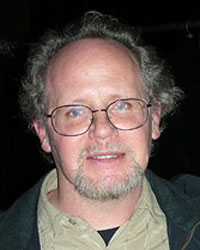
| Jacket 37 — Early 2009 | Jacket 37 Contents page | Jacket Homepage | Search Jacket |
The Internet address of this page is http://jacketmagazine.com/37/r-ballardini-rb-hill.shtml
Anny Ballardini
Ghost Dance in 33 Movements
reviewed by
Crag Hill
Otoliths, 2009, 80 pp. ISBN: 978-0-9805096-8-7 (available from http://www.lulu.com/content/5806078)
This review is about 3 printed pages long.
It is copyright © Crag Hill and Jacket magazine 2009.
See our [»»] copyright notice.
1
Anny Ballardini’s collection of ekphrastic poems, Ghost Dance in 33 Movements, is driven by the eye and mind in concert, by measured observation. Studying dozens of films streaming from UbuWeb into her Bolzano, Italy home, she writes a response to each film that is at once art scholarship, literary criticism, and poetry. Exceptionally erudite (as a graduate thesis must be, yet this exceeds expectations), quotation rich (Proust, Wittgenstein, Joyce, Whalen, Frankl, among many others), Ballardini is an exhaustive qualitative researcher, jotting copious notes on the films, her subjects, then presenting her findings, her own poems. (To continue the generative process, someone should make films based on her poems.)
Paragraph 2
Ekphrasis has long been a practice for poets (I hear the sound poems inspired by the cave paintings in Lascaux), poetry pirouetting off canvases, sculptures, whirring frames of film, the acts of viewing spawning the acts of writing, the source work given new life in a different medium, a mutually beneficial symbiosis. Yet no matter the relationship between the two, the newly created work must stand on its own, must become more than a static body of observations. In this collection, ultimately, the majority of the poems do stand on their own, commanding their own space, especially in the second half of the book.
3
The most prevalent pattern Ballardini employs in most of the poems is to first describe the film in a kind of voice over, a narration brimming with telegraphic sentences, nouns, noun phrases, gerunds, with indications of sound, setting, action:
4
black screen_voice out of field_experience of a journey / tragic odyssey
ice
light blue colors
intensely alive
snow_muffled padded sound of white chunks cracking in the water
lyrical songs by whales diving black shiny skin
(from “6. Pierre Huyghe, A Journey That Wasn’t”)
5
At the next stage of the process–each poem goes through a comparable metamorphosis, celluloid to observer to poet to poem–the pieces grow into a larger contextual space. The poet as critic, critic as poet, situates the original work firmly within the world of twentieth century Western art:
6
Malevich and Rodchenko with Suprematist fringes
in Mondrian-like patterns but grey & white
neo-plastic statues
Tinguely’s
artistic freely natural moving conveyed
into an irregular iron-like cacophony
(from “20. Gyorgy Ligeti, Poeme Symphonique for 100 metronomes”)
7
In the culminating stage, the poet, the scholar, the art critic, the audience and the performer, rolled up into one, briskly dance with the art work, the poem immersed in the art at the same time it emerges:
8
the triumph of measuring and regulating instruments’ tempo
micropolyphony in metaphysical terms: immanence in time_static
time as anarchic moving lines
uncoordinated beats per minute/s
the 100 metronomes one similar to the other
make individuality impossible
pulse is One
it does not matter which one
here’s the notion of Ligeti’s concert in 1962.
(from “20. Gyorgy Ligeti, Poeme Symphonique for 100 metronomes”)
9
Some of the poems telescope this pattern, the beginning in stage two, description mixed with contextual commentary, the poet immediately engaging the work hand-in-hand with the observer:
10
Ballet mécanique
le peintre Fernand Léger 1924
premier film sans scénario
présenté dans toute le capitales d’Europe
Man Ray’s hand
Fernand Léger’s drawing
MR’s sensuality /sexuality & cynicism
FL’s mechanical insight /intersecting gears /primary colors
MR’s poetic merging of fluffy/harsh visions on FL’s abrupt cut repetitive shapes
( from “17. Fernand Léger, Ballet mécanique 1924”)
11
In the best poems, the description of the film and the resulting poem are inseparable. In “21. Samuel Beckett, Not I,” following a brief report on the writer, the poem whirls with/within the description:
existentialism turned into postmodernism & minimalism
for the Irish author
secretary of Joyce
monosyllabic anguished words
in crescendos to:
. . .what? . .who? . .no! . . she! . .
yelled and then a pause
in uncomfortable waves
her voice reaches out to disturb
a rounded mouth in the darkness
lipstick on pulled lips
12
The last nine lines of “10. Nam June Paik, Fluxfilm 01: Zen For Film,” particularly stand out, film and poem intertwined:
13
white etched in black stuck in eternal glitch caught
in the net a tent clinging in vertical twirls
blinding glitter blurring lines
a nit without whirr in
nature a twig
in ether a
white
static
wing
14
In this collection of writings many forces converge: wide-ranging study of avant garde film, film as an international medium criss-crossing sociocultural boundaries, the rich tradition of ekphrastic writing, and the individual work/artist as it/he/her fits into an historical community of art/artists. Initially these forces overwhelm the poems, the works tilting heavily toward scholarship, but in the end the collection justifies its raison d’etre, the poetry dancing with the films.
15
Ballardini’s ghost dance connects us with our artistic predecessors. As with Native American ghost dances, these poems keep traditions and cultures alive. As Ballardini writes in the opening poem, “What we see of the world is the mind’s/Invention… ” In her inventive poems, Ballardini has reinvented these works of art. That’s probably more than you could ever expect from one book of poems.

Crag Hill
Crag Hill currently is the editor and publisher of Many Penny Press. He edited Score, a magazine devoted entirely to concrete/visual poetry for twenty years. In the last three decades his work has appeared in over 100 journals and anthologies, including several available on-line. His creative and critical works in progress can be found at http://scorecard.typepad.com